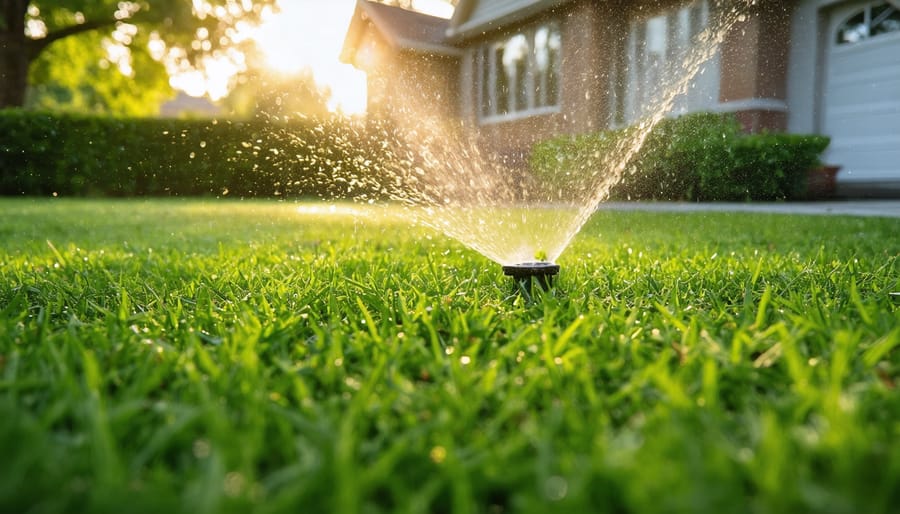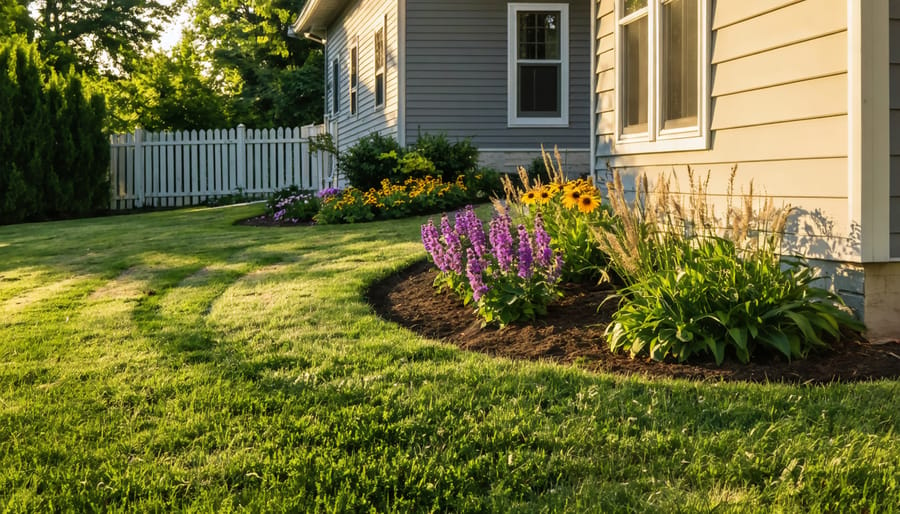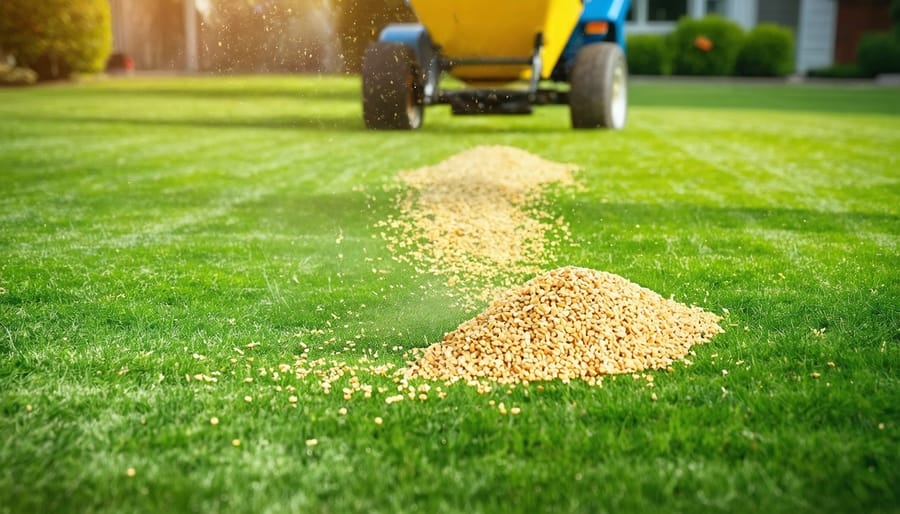Adjust your mowing height to 2-3 inches during peak growing season, then raise it to 3-4 inches when summer drought stress hits—taller grass develops deeper roots that access moisture more effectively and shades the soil to reduce evaporation. Water deeply but infrequently, applying 1-1.5 inches per week in early morning hours (ideally between 4-8 AM) to minimize fungal issues and maximize absorption, and reduce this to every 10-14 days during dormancy when your zoysia naturally turns tan or light brown to conserve resources.
Schedule your core aeration for late spring when soil temperatures reach 65-70°F and your lawn actively grows, creating channels that improve water penetration and root development before stress periods arrive. Apply a slow-release, nitrogen-rich fertilizer in late spring and midsummer at rates appropriate for your specific zoysia variety—typically 2-4 pounds of nitrogen per 1,000 square feet annually—but skip fertilization entirely once drought sets in, as pushing growth during water stress creates more harm than good.
The secret to thriving zoysia lies in working with its natural rhythms rather than against them. This warm-season grass enters semi-dormancy during extreme heat and cold, a survival mechanism that’s completely normal and actually protects your lawn investment. Understanding when to maintain actively and when to let your zoysia rest separates successful lawns from struggling ones, especially when implementing summer heat strategies that balance water conservation with lawn health. Your maintenance schedule should flex with seasons, temperatures, and rainfall patterns rather than following rigid calendar dates.
Understanding Zoysia’s Summer Personality

Why Zoysia Loves Heat (But Still Needs Your Help)
Zoysia grass is a warm-season champion that thrives when temperatures climb between 80-95°F, which is exactly when cool-season grasses start waving the white flag. Its secret weapon? A deep, efficient root system that can reach down 2 feet or more, accessing moisture reserves that other grasses can’t touch. During hot spells, zoysia naturally enters a self-preservation mode, slowing its growth and conserving resources rather than burning out completely.
Here’s where it gets interesting though. While zoysia is remarkably heat-tolerant, it’s not invincible. Think of it like a marathon runner who’s built for the distance but still needs water stations along the way. When temperatures consistently spike above 95°F or drought conditions persist for weeks, even this tough grass needs your intervention. You’ll notice it entering dormancy earlier than usual, with blades turning a grayish-green before going fully brown.
The good news? This dormancy is usually a survival strategy, not a death sentence. By understanding when zoysia is simply coasting through heat versus when it’s genuinely struggling, you can provide targeted support through adjusted watering schedules and reduced mowing stress, helping your lawn emerge stronger when conditions improve.
The Drought Tolerance Truth
Let’s clear up a common misconception: while zoysia is indeed more drought-tolerant than many other turfgrasses, it’s not invincible. I’ve seen too many homeowners lose beautiful lawns because they believed the “set it and forget it” myth about zoysia’s water needs.
Here’s the reality. Zoysia has deep roots and can survive extended dry periods by going dormant, turning brown and crispy until rain returns. But surviving isn’t the same as thriving. If you want your lawn to stay green and actively growing through summer, you’ll need to provide supplemental water during drought conditions.
Most zoysia varieties need about 1 to 1.5 inches of water per week during active growth. When temperatures soar above 90 degrees and rain is scarce, your zoysia will show stress signs within 7 to 10 days without irrigation. You’ll notice footprints lingering on the grass, a bluish-gray tint, and blades folding inward.
The sustainable approach? Water deeply but infrequently, encouraging those robust roots to dig even deeper. Early morning watering minimizes evaporation and disease risk. During extreme drought, you can let zoysia go dormant temporarily without permanent damage, but understand this choice means a brown lawn until conditions improve. It’s drought-tolerant, not drought-proof.
Your Month-by-Month Summer Maintenance Schedule
Early Summer (June): Getting Ahead of the Heat
June marks the transition into the heat of summer, and your zoysia lawn is shifting into full growth mode. This is the perfect time to fine-tune your maintenance routine and prepare for the hotter, drier weeks ahead. Think of it as setting your lawn up for success rather than playing catch-up later.
Start by adjusting your mowing height to around 2 to 2.5 inches. This might feel counterintuitive since zoysia can tolerate lower cuts, but leaving it slightly taller during summer helps shade the soil, reduces water evaporation, and encourages deeper root growth. Those deeper roots will be your lawn’s lifeline when drought conditions arrive. Mow regularly, removing no more than one-third of the blade height at a time, and keep those mower blades sharp for clean cuts that heal quickly.
If you applied fertilizer in late spring, you can hold off for now. However, if you’re following a split application schedule, early June is your window for a light feeding with a slow-release, nitrogen-based fertilizer. About one pound of nitrogen per 1,000 square feet is plenty. Remember, zoysia doesn’t need heavy feeding like some other grasses, and overdoing it can actually stress the lawn during hot weather while contributing to runoff pollution.
Now’s also the time to evaluate your irrigation system. Check for clogged sprinkler heads, adjust spray patterns to avoid watering sidewalks, and program your timer for early morning watering between 4 and 8 AM. This timing minimizes evaporation and gives grass blades time to dry, reducing disease risk. Aim for about one inch of water per week, including rainfall. A simple rain gauge or empty tuna can helps you monitor this accurately.
Pre-drought preparation means encouraging resilience. Consider aerating if you haven’t done so in the past year, as this improves water penetration and root development. Apply a thin layer of compost to improve soil moisture retention naturally, supporting your sustainability goals while reducing future irrigation needs.
Mid-Summer (July-August): Surviving Peak Stress
July and August can feel like a test of endurance for both you and your zoysia lawn. The good news? Zoysia is naturally adapted to handle heat stress far better than cool-season grasses. The key is working with your lawn’s survival instincts rather than against them.
During peak summer heat, your zoysia will naturally slow its growth as a protective mechanism. This means you can actually reduce your mowing frequency—sometimes to just once every two weeks instead of weekly. When you do mow, raise your cutting height by about half an inch from your spring setting. Taller grass blades shade the soil, reducing moisture loss and helping roots stay cooler. Think of it as your lawn putting on a sun hat.
Watering strategy becomes critical now, but here’s where many well-intentioned lawn owners go wrong. Deep, infrequent watering beats shallow, frequent watering every time. Aim for about one inch of water per week, including rainfall, delivered in one or two deep soaking sessions. Water in the early morning between 4 and 9 a.m. to minimize evaporation and fungal issues. If you’re facing water restrictions, know that zoysia can survive with less—it may go dormant and turn tan, but it will bounce back when conditions improve.
When stress appears, resist the urge to overcompensate. A lawn showing drought stress with a bluish-gray tint and footprints that remain visible is simply asking for water, not a crisis requiring fertilizer or other interventions. In fact, skip fertilizing entirely during July and August. Feeding a stressed lawn forces new growth that demands more water and makes your grass even more vulnerable.
What about those brown patches that suddenly appear? Before panicking, check if they’re actual dead spots or dormancy. Gently tug on the grass—if it pulls up easily with no root resistance, you might have a pest or disease issue. If it resists pulling and the crowns still look alive, it’s likely just dormant and protecting itself.
The most sustainable approach during these brutal months is simple: less is more. Let your zoysia do what it does best—survive. Your restraint now means a healthier, more resilient lawn come September.
Late Summer (September): Recovery and Transition
September marks a turning point for your zoysia lawn. After enduring the heat and potential drought stress of summer, your grass is ready to bounce back with some thoughtful care. This transition month is when you’ll notice your lawn starting to perk up as temperatures moderate and it prepares for one last growth surge before dormancy.
First, assess the damage. Walk your lawn and identify areas that struggled most during summer. Brown patches that don’t green up with watering may need attention, but don’t panic if your lawn looks a bit tired. Zoysia is remarkably resilient and often recovers beautifully with proper care.
As temperatures drop into the 70s and 80s, gradually resume normal watering practices. If you’ve been deep watering weekly during drought, continue this schedule early in the month. By mid-September, as cooler weather arrives and natural rainfall increases in many regions, you can typically reduce supplemental irrigation. Always check soil moisture before watering to avoid overwatering during this transition.
Mowing frequency should increase as your lawn responds to cooler temperatures and adequate moisture. Return to your standard 1.5 to 2-inch cutting height if you raised it during peak summer stress. Keep those blades sharp to avoid tearing stressed grass that’s working hard to recover.
This is also prime time for fall fertilization. A balanced, slow-release fertilizer applied in September gives your zoysia the nutrients it needs to recover from summer stress and build strong roots before winter. This feeding sets the foundation for vibrant spring green-up.
Consider core aeration if your lawn experienced heavy foot traffic or compaction during summer. September’s conditions are ideal for this task, allowing your zoysia to recover quickly while building resilience for next season.
Smart Watering Strategies That Actually Work
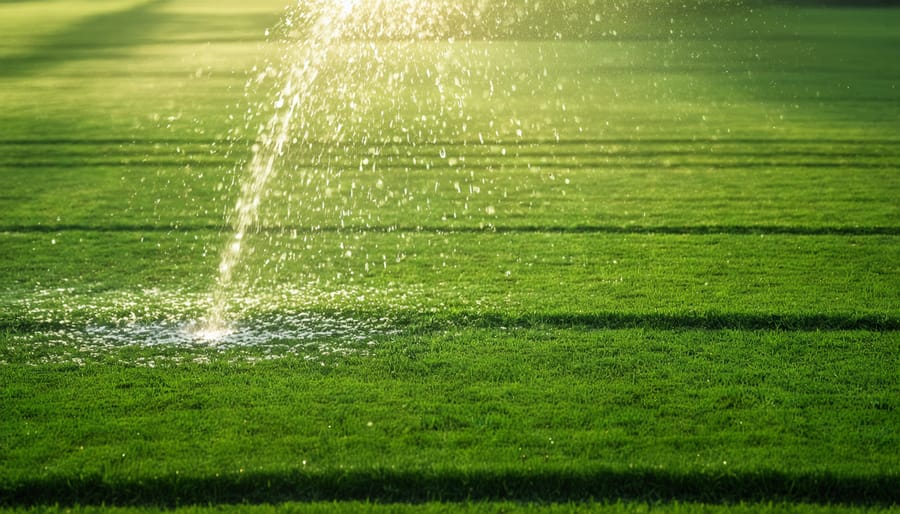
The Deep and Infrequent Method
Here’s the secret to a resilient zoysia lawn during summer’s toughest moments: water deeply but less often. This approach might feel counterintuitive when you see your grass looking thirsty, but it’s one of the most sustainable and effective strategies for drought management.
Deep watering encourages zoysia roots to grow downward, sometimes reaching 12 inches or more into the soil. These deep roots access moisture that surface-level watering never touches, making your lawn naturally more drought-resistant. When you water frequently but shallowly, roots stay near the surface, leaving your grass vulnerable the moment conditions get harsh.
So how do you know if you’re watering deeply enough? Aim for 6 to 8 inches of soil penetration. The screwdriver test is your best friend here—push a long screwdriver into your lawn about 30 minutes after watering. If it slides in easily to at least 6 inches, you’ve hit the sweet spot. If not, run your sprinklers longer next time.
During drought periods, zoysia typically needs about 1 to 1.5 inches of water per week, delivered in one or two sessions rather than daily sprinkles. Early morning watering between 4 and 8 AM minimizes evaporation and gives grass blades time to dry, reducing disease risk. This water-efficient summer care approach conserves resources while keeping your zoysia healthy and ready to bounce back when conditions improve.
Reading Your Lawn’s Thirst Signals
Your zoysia grass is remarkably good at communicating its water needs, but you need to know its language. The most reliable method is the footprint test. Simply walk across your lawn and look back. If your footprints remain visible for more than a few seconds because the grass blades haven’t sprung back, your lawn needs water. This works because well-hydrated grass is turgid and resilient, while thirsty grass lacks the internal water pressure to bounce back.
Color changes also tell an important story. When zoysia needs water, it develops a bluish-gray tint rather than its typical healthy green. The blades may also begin to fold or curl slightly, trying to reduce their surface area and conserve moisture. Here’s where sustainable lawn care gets interesting: sometimes what looks like drought stress is actually your zoysia entering its natural dormancy mode. True drought dormancy happens gradually over weeks, turning the entire lawn tan or brown uniformly. This is a protective mechanism, not death. Your grass is simply going dormant to survive, much like it does in winter. If you’re seeing the bluish tint and slow recovery from footprints before widespread browning, that’s your cue to water. Once dormant, the most sustainable approach is letting it rest rather than forcing it to stay green.
Water Restrictions and Survival Mode
When water restrictions hit or severe drought takes hold, zoysia’s natural drought tolerance becomes your best friend. This warm-season grass enters a protective dormancy mode, turning straw-colored but staying alive underground. Your goal isn’t a picture-perfect lawn, it’s survival.
If watering is allowed even once every two to three weeks, focus your efforts strategically. Water deeply in the early morning, applying just enough to wet the soil 4-6 inches down. Target high-traffic areas and spots near walkways where heat stress intensifies. Skip the fertilizer completely during this period, as it encourages growth the lawn can’t sustain.
Raise your mower height to the maximum recommended for your zoysia variety, typically around 2-3 inches. Taller grass shades roots and conserves moisture. If growth stalls, stop mowing entirely rather than scalping dormant turf.
Expect your lawn to look rough, and that’s okay. Zoysia can survive months without water, bouncing back impressively once conditions improve. Avoid walking on dormant areas when possible, as stressed grass is more vulnerable to damage. Think of this phase as your lawn’s hibernation, it’s conserving energy for the comeback you’ll see when rain returns or restrictions lift.
Mowing Through the Heat: Height and Frequency Adjustments
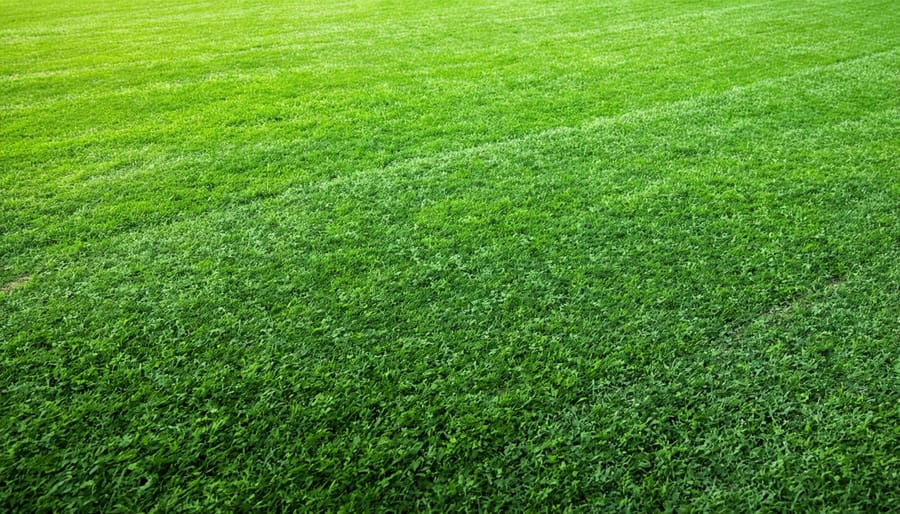
The Drought-Height Sweet Spot
When your zoysia lawn is dealing with drought stress, resist the temptation to scalp it short. Instead, raise your mower deck to about 2 to 2.5 inches, which is higher than the typical 1 to 2 inches for well-watered zoysia. This extra height might seem counterintuitive, but it’s actually your lawn’s best friend during tough conditions.
Taller grass blades create more shade for the soil surface, reducing moisture evaporation and keeping roots cooler. They also have more leaf surface area to photosynthesize, helping your stressed lawn maintain energy reserves. Think of it as giving your grass a protective umbrella during a heat wave.
Before adjusting your cutting height, make sure your mower maintenance is current with sharp blades. Dull blades tear grass instead of cutting cleanly, leaving ragged edges that lose even more precious moisture and invite disease.
Keep this higher setting throughout the drought period, and only gradually lower it once consistent rainfall or irrigation returns. Your zoysia will thank you with better color retention and faster recovery.
When to Skip a Mowing
Your zoysia lawn will tell you when it needs a break from the mower, and learning to read these signals is one of the kindest things you can do during stressful periods. When growth naturally slows, continuing your regular mowing schedule can actually do more harm than good.
The most obvious sign is simply slower growth. If you normally mow weekly and notice your grass hasn’t reached the ideal cutting height after seven days, that’s your lawn asking for a pause. During drought or extreme heat, zoysia enters a semi-dormant state as a survival mechanism, conserving water and energy by slowing blade production. Respect this wisdom and skip that mowing.
Check the color too. When zoysia shifts from its vibrant green to a duller, slightly grayish-green hue, growth has definitely slowed. The grass blades may also feel slightly stiffer or more upright rather than lush and pliable. These are all perfectly normal stress responses, not signs of a dying lawn.
Skipping unnecessary mowing during these periods is genuinely sustainable lawn care in action. Each time you mow, you’re creating wounds that require energy to heal and moisture to recover. When your lawn is already struggling to maintain hydration, why add that stress? You’ll also conserve fuel, reduce emissions, and give beneficial insects living in your turf a much-needed refuge.
A good rule of thumb: if your lawn hasn’t grown at least half an inch since the last cut, let it rest. Your zoysia will thank you by bouncing back stronger when conditions improve.
Summer Fertilization: Less Is More
The Case for Skipping Mid-Summer Feeding
Here’s the thing about zoysia during those scorching July and August weeks: your lawn is already working overtime just to survive. When temperatures soar and rainfall becomes scarce, zoysia naturally shifts into self-preservation mode, slowing its growth and conserving resources. Adding fertilizer during this stress period is like asking someone running a marathon to also juggle—it’s just too much.
Fertilizing during peak summer drought actually forces your lawn to produce new growth when it’s least equipped to do so. That tender new growth requires extra water your stressed lawn simply doesn’t have, making it more vulnerable to heat damage, disease, and insect problems. You’re essentially creating demand when supply is critically low.
Most established zoysia lawns thrive on just two to three fertilizer applications per year, typically in late spring and early fall when conditions favor healthy growth. If you fertilized in June, your lawn has plenty of nutrients stored to coast through summer’s tough conditions.
The sustainable approach? Give your zoysia a break during peak heat. Focus instead on proper watering techniques and raising your mower height slightly to protect roots. Your lawn will thank you come September when it naturally rebounds and puts that stored energy to work, greening up beautifully without the stress-induced problems mid-summer feeding creates.
Light Feeding for Healthy Lawns Only
Here’s a truth that might surprise you: healthy zoysia lawns in early summer rarely need fertilizing, especially during drought conditions. If your lawn is already stressed from heat or lack of water, hold off entirely. Fertilizer pushes grass to grow, which demands more water and energy—exactly what a struggling lawn can’t spare.
However, if your zoysia is thriving and you’ve had adequate rainfall, a light feeding can support continued health. The key word here is light. Choose a slow-release, organic fertilizer with a balanced ratio like 3-1-2 or similar. Apply at half the recommended rate—seriously, less is more with zoysia. These low-maintenance grasses evolved to thrive in less-than-ideal conditions, so they don’t demand heavy feeding like cool-season grasses.
Timing matters too. Understanding proper fertilization timing means applying early in the month when temperatures are still moderate and rain is more likely. Water thoroughly after application to move nutrients into the soil and prevent burn. If drought hits mid-summer, skip this feeding altogether—your zoysia will thank you for the break, and you’ll conserve resources while supporting sustainable lawn care practices.
Trouble-Shooting Common Summer Zoysia Problems
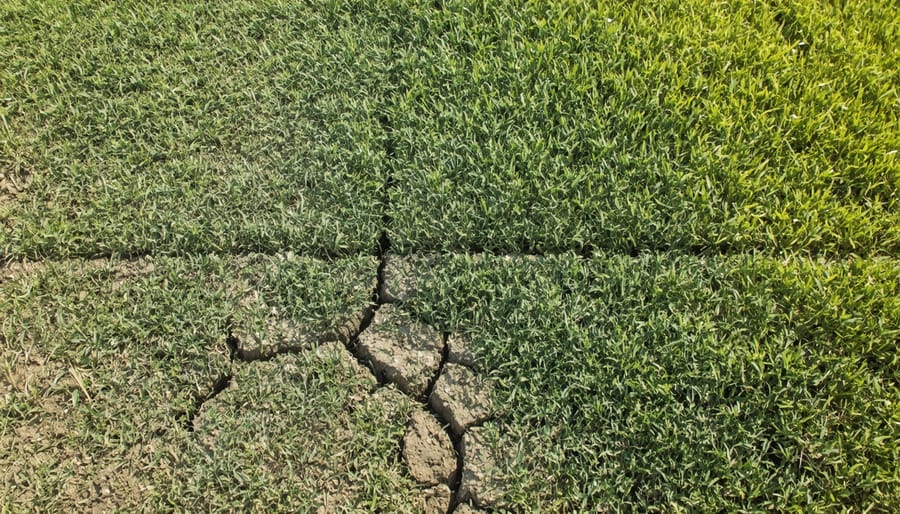
Brown Spots: Problem or Protection?
Spotting brown patches on your zoysia can feel alarming, but here’s some good news: not all browning means trouble. During summer heat, your lawn is basically telling you a story, and learning to read it makes all the difference.
Healthy dormancy is zoysia’s natural survival mode. When temperatures soar above 95°F consistently, your lawn may enter a light dormancy even in summer, turning a straw-like tan color uniformly across the lawn. This is actually protection, not a problem. The grass is conserving energy and will bounce back when conditions improve. Think of it as your lawn taking a strategic nap.
Drought stress looks different. You’ll notice brown patches appearing in high-traffic areas or spots with poor drainage first, while other areas remain green. The grass blades fold inward or take on a bluish-gray tint before browning. Press your footprint into the lawn—if it stays visible for more than a few seconds, your zoysia needs water soon.
True problems requiring intervention have distinct patterns. Fungal diseases create irregular brown patches with darker rings around the edges. Grub damage shows as loose, easily-lifted sections of turf. Chinch bug damage appears as yellowing patches that expand outward, often near hot, sunny areas like driveways.
Here’s your quick check: tug gently on brown grass. Dormant or drought-stressed grass stays firmly rooted. Diseased or pest-damaged grass pulls up easily. When in doubt, a sustainable approach wins—give your lawn a deep watering first and wait 48 hours. Healthy zoysia responds quickly, while actual problems persist.
Summer Pests and Diseases
Summer brings its share of challenges for zoysia lawns, but recognizing issues early makes all the difference. The good news? Zoysia’s natural drought tolerance means you can address problems without overreacting and adding unnecessary stress to already-challenged grass.
Chinch bugs are perhaps the most common summer pest you’ll encounter. These tiny insects suck nutrients from grass blades, creating irregular yellow patches that quickly turn brown. Look for them at the edge of damaged areas by parting the grass down to the soil level. If you spot small black bugs with white wings scurrying about, you’ve found your culprit. Before reaching for broad-spectrum insecticides, try a more sustainable approach: spray affected areas with soapy water or consider beneficial nematodes, which naturally target chinch bugs without harming your lawn’s ecosystem.
Brown patch fungus thrives in hot, humid conditions, appearing as circular brown areas with a distinctive smoke-ring border. The key here is prevention through smart watering practices. Water deeply but infrequently in the early morning, allowing foliage to dry quickly. If brown patch does appear, resist the urge to fertilize or water more frequently, as this actually encourages fungal growth. Instead, improve air circulation by maintaining proper mowing height and removing excess thatch.
During drought conditions, remember that some browning is simply dormancy, not disease. A stressed lawn fighting pests or disease shows irregular patterns and pulls up easily, while dormant grass remains firmly rooted with uniform color changes. This distinction helps you avoid unnecessary treatments when your zoysia is simply conserving energy.
Here’s the liberating truth about zoysia maintenance: sometimes the best thing you can do is step back and let nature take its course. Throughout this guide, we’ve focused on working with zoysia’s incredible natural resilience rather than fighting against it with excessive inputs and constant intervention. This philosophy becomes especially important during those challenging summer months when your instinct might be to do more, when often less is exactly what your lawn needs.
When drought stress hits and your zoysia goes dormant, remember that this isn’t failure. It’s survival brilliance honed over thousands of years. Those brown blades aren’t dying; they’re protecting the crown and root system that will spring back to vibrant green when favorable conditions return. Resist the urge to over-fertilize, scalp the turf, or drown it with daily watering. These well-intentioned efforts usually create more problems than they solve.
The wonderful news? Zoysia’s recovery capacity is truly remarkable. As temperatures moderate and fall rains arrive, you’ll be amazed at how quickly your lawn bounces back from summer stress. Patient gardeners are consistently rewarded with healthier, more sustainable lawns than those who push too hard during peak stress periods.
By embracing these sustainable maintenance practices, you’re not just caring for your lawn. You’re conserving water, reducing chemical inputs, and working in harmony with your landscape’s natural rhythms. That’s lawn care worth celebrating, and your resilient zoysia will thank you with years of beautiful, low-maintenance performance.
